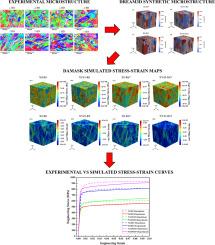增材制造316L不锈钢力学各向异性结晶塑性建模:构建取向和扫描旋转角度的影响
IF 2.9
Q2 MATERIALS SCIENCE, MULTIDISCIPLINARY
引用次数: 0
摘要
激光粉末床熔合316l -不锈钢(316L-SS)在强度和塑性方面表现出明显的力学各向异性。该研究表明,各向异性主要受构建方向(BOs)和扫描旋转角度(SRAs)的影响。实验研究了关键的控制机制,揭示了位错密度的变化起主导作用,而晶体织构的差异进一步促进了各向异性响应。为了更好地理解这种行为,开发了一种新的晶体塑性有限元模型(CPFEM)来模拟力学各向异性。选择两个最具代表性的BOs(0°为X0, 45°为XY45)和sra(0°为R0, 67°为R67),所有样品都在水平面上印刷。利用实验计算的位错密度和每种情况下的微观结构数据,生成合成的代表性体积元(rve),并使用开源的DAMASK软件进行力学模拟。在所有条件下,模拟的应力-应变曲线与实验结果非常吻合,XY45-R67样品的最大误差为10%。这表明所建立的模型有效地捕捉了位错密度变化和微观结构特征对不同BOs和SRAs引起的力学各向异性的影响。本文章由计算机程序翻译,如有差异,请以英文原文为准。

Crystal plasticity modeling of mechanical anisotropy in additive manufacturing 316L stainless steel: Influence of build orientation and scan rotation angle
316L-stainless steel (316L-SS) fabricated via laser powder bed fusion (LPBF) exhibits significant mechanical anisotropy in terms of strength and ductility. This study demonstrates that anisotropy is primarily influenced by build orientations (BOs) and scan rotation angles (SRAs). The key governing mechanisms were investigated experimentally, revealing that variations in dislocation density play a dominant role, while crystallographic texture differences further contribute to the anisotropic response. To better understand this behavior, a novel crystal plasticity finite element modeling (CPFEM) was developed to simulate mechanical anisotropy. The two most representative BOs (0° as X0 and 45° as XY45) and SRAs (0° as R0 and 67° as R67) were selected, with all samples printed on the horizontal plane. Using experimentally calculated dislocation density and microstructural data for each case, synthetic representative volume elements (RVEs) were generated and employed in mechanical simulations using the open-source DAMASK software. The simulated stress–strain curves closely matched the experimental results across all conditions, with a maximum error of 10% observed for the XY45–R67 sample. This demonstrates that the developed model effectively captures the influence of dislocation density variations and microstructural characteristics on mechanical anisotropy induced by different BOs and SRAs.
求助全文
通过发布文献求助,成功后即可免费获取论文全文。
去求助
来源期刊

Materialia
MATERIALS SCIENCE, MULTIDISCIPLINARY-
CiteScore
6.40
自引率
2.90%
发文量
345
审稿时长
36 days
期刊介绍:
Materialia is a multidisciplinary journal of materials science and engineering that publishes original peer-reviewed research articles. Articles in Materialia advance the understanding of the relationship between processing, structure, property, and function of materials.
Materialia publishes full-length research articles, review articles, and letters (short communications). In addition to receiving direct submissions, Materialia also accepts transfers from Acta Materialia, Inc. partner journals. Materialia offers authors the choice to publish on an open access model (with author fee), or on a subscription model (with no author fee).
 求助内容:
求助内容: 应助结果提醒方式:
应助结果提醒方式:


